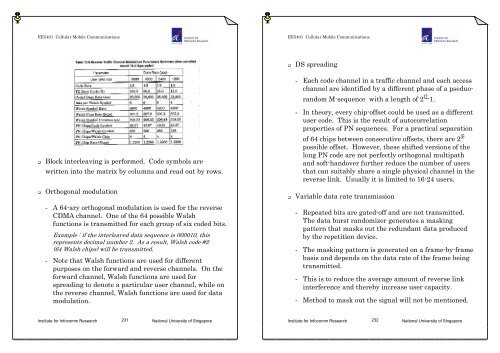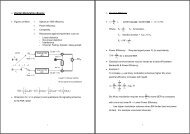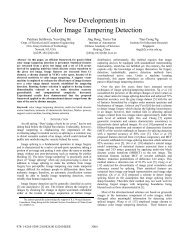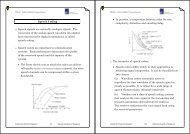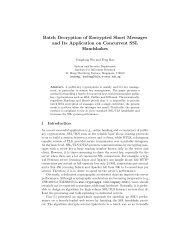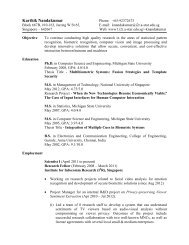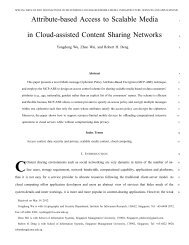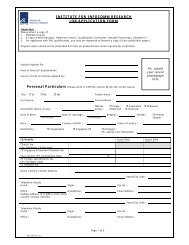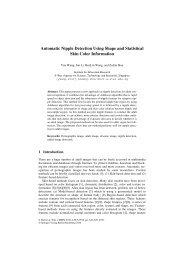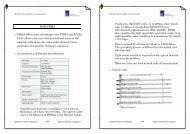IS-95 CDMA CDMA offers some advantages over TDMA and FDMA ...
IS-95 CDMA CDMA offers some advantages over TDMA and FDMA ...
IS-95 CDMA CDMA offers some advantages over TDMA and FDMA ...
You also want an ePaper? Increase the reach of your titles
YUMPU automatically turns print PDFs into web optimized ePapers that Google loves.
EE5401 Cellular Mobile CommunicationsEE5401 Cellular Mobile CommunicationsDS spreading- Each code channel in a traffic channel <strong>and</strong> each accesschannel are identified by a different phase of a pseduor<strong>and</strong>omM-sequence with a length of 2 42 -1.Block interleaving is performed. Code symbols arewritten into the matrix by columns <strong>and</strong> read out by rows.- In theory, every chip-offset could be used as a differentuser code. This is the result of autocorrelationproperties of PN sequences. For a practical separationof 64 chips between consecutive offsets, there are 2 36possible offset. However, these shifted versions of thelong PN code are not perfectly orthogonal multipath<strong>and</strong> soft-h<strong>and</strong><strong>over</strong> further reduce the number of usersthat can suitably share a single physical channel in thereverse link. Usually it is limited to 16-24 users.Orthogonal modulationVariable data rate transmission- A 64-ary orthogonal modulation is used for the reverse<strong>CDMA</strong> channel. One of the 64 possible Walshfunctions is transmitted for each group of six coded bits.Example : if the interleaved data sequence is 000010, thisrepresents decimal number 2. As a result, Walsh code #2(64 Walsh chips) will be transmitted.- Note that Walsh functions are used for differentpurposes on the forward <strong>and</strong> reverse channels. On theforward channel, Walsh functions are used forspreading to denote a particular user channel, while onthe reverse channel, Walsh functions are used for datamodulation.- Repeated bits are gated-off <strong>and</strong> are not transmitted.The data burst r<strong>and</strong>omizer generates a maskingpattern that masks out the redundant data producedby the repetition device.- The masking pattern is generated on a frame-by-framebasis <strong>and</strong> depends on the data rate of the frame beingtransmitted.- This is to reduce the average amount of reverse linkinterference <strong>and</strong> thereby increase user capacity.- Method to mask out the signal will not be mentioned.Institute for Infocomm Research 231National University of SingaporeInstitute for Infocomm Research 232National University of Singapore


